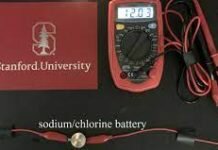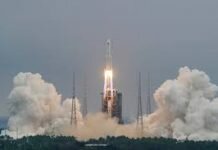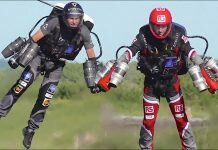
SpaceX’s Starship Serial Number 10 (SN10) exploded roughly 10 minutes after landing on the launch pad following its first high altitude test flight that sent the massive rocket soaring six miles into the air.
The failure occurred after SpaceX declared it a success, as SN10 flew, flipped and landed without crashing and burning like the previous prototypes SN8 and SN9 – CEO Elon Musk praised the rocket in a tweet for ‘landing in one piece.’
‘Third time’s a charm, as the saying goes,’ SpaceX principal integration engineer John Insprucker said during SpaceX’s livestream Wednesday.
‘We’ve had a successful soft touchdown on the landing pad that’s capping a beautiful test flight of Starship 10.’
The cause of the explosion has not yet been revealed, but Musk has referred to such events as ‘RUDs,’ or Rapid Unplanned Disassembly.
Some sources speculate the landing legs attached to the base did not deploy and sent the rocket toppling over, while others say there was a methane leak.
SN10 took off from SpaceX’s Boca Chica, Texas testing facility at 6:15pm ET, following the same path as both the SN8 and SN9 prototypes that exploded when attempting to land.
The rocket soared through the sky, propelled by its three powerful Raptor engines that turned off one by one until a single engine was left.
SN10 reached the six-mile mark four minutes into its flight and hovered above the earth using a single engine before turning on its side for the ‘belly flop.’
As SN10 headed back to the launch pad, it re-orientated itself to land vertically and touched down as smoke came blowing out from the base – but it suffered the same fate as its predecessors shortly after.
However, the prototype’s mission was to gather data on controlling the rocket during re-entry and many are calling the launch a success rather than another Starship failure.
SN10 was patiently waiting on the launch pad for its chance to follow in the steps of the SN8 and SN9 prototypes.
The rocket was set to take off at 3:20pm ET, but moments after the rocket ignited its Raptor engines the onboard computers activated an abort due to a detected issue.
Musk tweeted shortly after the halt saying: ‘Launch abort on slightly conservative high thrust limit. Increasing thrust limit & recycling propellant for another flight attempt today.’
The SpaceX team worked quickly detanking and refueling the 165-foot stainless steel vehicle with the hopes that it would take flight later that day – and their wishes were granted.
Although SpaceX seems to be focused on reaching the maximum altitude with Starships, the entire agenda of these flights is to gather data and test key mechanics on the rockets.
Igniting all three Raptor engines for liftoff and then shutting them off one by one are all intentional actions, which also saves energy for when they need to power back on to lower the massive rocket to the launch pad.
The decent was controlled under active aerodynamic control, accomplished by independent movement of two forward and two aft flaps on the vehicle, all of which SpaceX was set on testing during this mission.
Insprucker said following the successfully landing that the next prototype, SN11, is ‘ready to roll out to the pad in the very near future.’
SN10 is nothing more than a pile of rubble, but the firm may have been able to capture all the data it needed and could announced the mission as a success – just as Musk did when the first prototype exploded.
SN8 took to the skies on December 10 – marking the first high altitude attempt of a Starship prototype.
The rocket hit all the marks including shutting down its Raptor engines, reaching an altitude of 7.8 miles and performing the belly flop.
The only thing it was unable to perfect was the landing, but Musk said previously that the rocket was unlikely to land safely.
The moment the rocket touched down, it ignited in flames and left nothing behind but its nose cone.
Then came the next prototype, SN9, which SpaceX had high hopes of landing when it attempted its high altitude test flight in February.
Daily mail










































